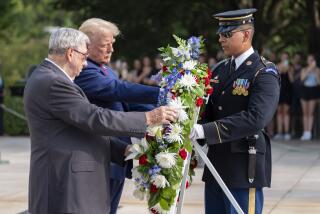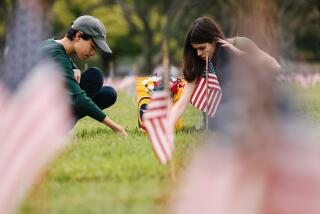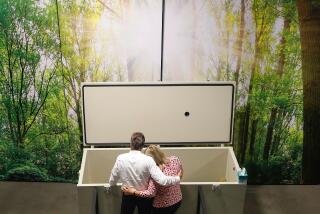Strains of Taps, Over and Over
Out where the grass meets the dirt, where life meets death, work begins early at the nationâs busiest veterans cemetery.
Shortly after 8 a.m., a backhoe peels away a foot and a half of hard clay to expose the dayâs crypts -- two rows of empty concrete boxes lined up a quarter-inch apart. Workers help the driver remove the 1,000-pound lids, then wait for the steady parade of hearses.
âWe used to have lulls, times when you didnât have much volume,â said Ed Lamoreaux, who has been opening and closing graves at Riverside National Cemetery for 15 years. âThere are no lulls out here anymore.â
Last year, there were 7,939 burials and inurnments at Riverside National Cemetery, which serves an area stretching across Southern California to Arizona and Nevada. On average, a memorial service is held here every 15 minutes, five days a week. The crack of rifle fire and the sound of taps drift on the air like background music broadcast by the wind.
As the World War II generation has aged, the pace at which veterans are dying -- more than 1,700 each day -- has strained the national cemetery system.
Half the 120 cemeteries run by the U.S. Department of Veterans Affairs are nearly out of burial space, and the wave of veteran deaths isnât expected to peak until 2008, with a projected 658,000 deaths that year.
Only about a third of Riverside National Cemeteryâs 920 acres -- an expanse equivalent to nearly 700 footballs fields -- near March Air Reserve Base have been developed.
When the cemetery reaches capacity sometime after 2030, Riverside will contain more than 1 million burial sites, making it among the largest cemeteries in the world.
âItâs hard with the volume we have not to appear like a production line,â said Richard Boyd, Riverside National Cemeteryâs assistant director. âThis is a very personal business, after all.â
Family members donât seem to mind the regimentation and close quarters. The military in death is a lot like the military in life: The cemetery is a study in efficiency.
It was among the first national cemeteries to use flat grave markers exclusively, in part because they are easier to maintain. As a result, Riverside doesnât have the somber feel of, say, Arlington National Cemetery, where row upon row of perfectly aligned tombstones stand at attention.
Riverside feels more like a vast, dimpled golf course quietly awaiting its first tee time.
In 1996, it became the first national cemetery to employ whatâs known in the burial business as presets. About 14,000 crypts are in the ground ready to be opened -- a two-year supply -- and new ones are being sunk all the time.
Graveside services are discouraged. Instead, mourners in their cars queue up at staging areas and are directed by a radio dispatcher to one of seven âcommittal shelters,â gazebos where services are held.
Afterward, caskets are delivered to the area of gravesites uncovered that morning and lowered into a numbered crypt. At dayâs end, the backhoe covers them all with dirt.
Within two months, granite markers are installed. Once a section is full, fast-growing grass seed is blown across the area. The sprinklers are connected and turned on.
âFamilies donât go out there and watch how the burials take place,â said Jack Gerbl, a San Jacinto funeral director who often arranges burials at the cemetery. âWhen you come back six months from now, it will look all green and pretty.â
*
An Orderly Day
By 10 a.m., the day is moving with military precision. Seven funerals are scheduled in the next 61 minutes. Six are for World War II vets.
Roy Sandau, Navy.
Carlos Torres, Navy.
Angel Ramirez, Navy.
Rose Sabo, Army.
Leonard Thompson, Army.
Frederick Romero, Army.
âMy brother is buried here. My daughterâs father is buried here. And a cousin,â said Barbara Romero, one of 18 family members attending her fatherâs funeral.
âMy dad wanted to be here too, because he thought it was so beautiful and serene.â
Born and raised in Los Angeles, Frederick Romero enlisted in the Army in 1942. He worked in communications.
He wanted to be in combat, but never was. After the war, Romero settled in La Habra and worked 38 years as a pattern maker for a menâs sportswear company. He had three children. He loved to dance. He was 80 when he died.
A gold box containing his ashes is placed on a table at Shelter G, which overlooks a lake with a fountain in its center. A 14-man military honor guard made up of retirees drives up in a white van and takes up positions. Members of the unit range in age from 57 to 82, work two days a month and are among the 500 volunteers who perform services at the cemetery.
Romeroâs service is their 543rd in the last five years.
âThis is 25,000 steps beyond a hobby,â Jim L. Griffin, a member of the unit, would say later. âItâs an honor. Itâs a pleasure.... Theyâre our brothers and sisters.â
Three riflemen fire off three rounds each. Taps is played. Barbara Romero is handed a folded U.S. flag and thanked for her fatherâs service to his country. The honor guard piles back into the van and drives off to the next appointment.
âFred would have loved that,â said the Rev. Jim Dale, himself a veteran who volunteers at the cemetery. âAll that for him.â
Half an hour later, Shelter C. Twelve-year-old Nicholas Pinkus plays taps. It was his grandfatherâs last request.
Angel Ramirez of Mira Loma spent 1941 through 1945 in the Navy. A boatswainâs mate, he was a master seaman who ferried troops to shore for battle. He transported MacArthur and Eisenhower too.
âHe loved being in the Navy,â said his widow, Doris, 77. âLoved being out on the ocean.â
Back home, he became an upholsterer and, later, superintendent of a furniture factory. He reluctantly retired two years ago at 79 because he wasnât feeling well.
A couple of months later, he was diagnosed with cancer. He always thought he would beat it.
Until the end, he was repairing and making furniture for friends and family. Many of the three dozen people at his service owned a piece made by Ramirez.
As they head back to their cars, a bagpipe squeals over at Shelter F.
Leonard Thompson of Santa Ana died at age 78, half a century after combat in the Philippines as an Army private.
âHe really didnât talk about it,â Kathleen Thompson said of her husband. âI donât know why. It was part of his life, but it was in his past. He put it aside so he could go forward.â
After the war, Thompson went to junior college and worked 35 years for Pacific Telephone & Telegraph Co. He started as a cable splicer, moved up to home installations and was promoted to installing telephone systems in businesses.
âHe enjoyed his life,â his widow said. âHe loved fishing. When he retired, weâd go down to Balboa and sit down with a cup of coffee and fish. Didnât matter if he caught anything.â
In April, Thompson had a stroke. Suddenly, inexplicably, he began talking about the war.
âAll he would talk about was his brother,â Kathleen Thompson said. âHe had been a pilot and was killed over France. I never heard him talk about his brother before. It bothered me.... You hear about people talking to loved ones on the other side. I donât know how else to explain it.â
Less than a hour later, Thompson is lowered into Section 57A, No. 218. Angel Ramirez is a quarter-inch away, in No. 217.
The numbers are spray-painted in red inside each crypt, and when a casket arrives its work order is checked and double-checked to make sure the numbers match.
*
An Emotionless Job
All that Steven Ferrell knows about the people he buries five days a week is their numbers.
It is all he needs to know. âI try to know as little as possible,â Ferrell said. âWith 8,000 every year, Iâd go insane if I had any personal involvement.â
Ferrell, 47, is typical of the men who tend to Riversideâs dead. Heâs a longtime employee; after eight years, he earns $14 an hour. Heâs older; the average age of Riversideâs staff is 56. And heâs a veteran: Army, 1970s.
There is a routine to the job that renders it emotionless. Ferrell and his crew of grave-diggers speak of 5-footers and 7-footers -- the shallower crypt is for single caskets, the deeper one roomy enough for a spouse to be laid on top later.
They know that Mondays and Fridays are the busiest days.
âEach day is the same,â Ferrell said. âThe only thing that changes are the numbers.â
As the afternoon light fades, the backhoe moves in and covers the now-occupied crypts. The men know to stand upwind.
When the brown cloud clears, a steamroller flattens the row. Then itâs raked out, and temporary plastic markers are staked at each spot.
âI have 12 friends of mine out there.... Thereâs Terry, John, Jesse, Willie,â Ferrell said, picking up bouquets of flowers from a pile, checking their numbers and placing them on the corresponding graves. âTheyâre our own, coming home to us. Someday, this will be our place too.â
More to Read
Sign up for Essential California
The most important California stories and recommendations in your inbox every morning.
You may occasionally receive promotional content from the Los Angeles Times.










